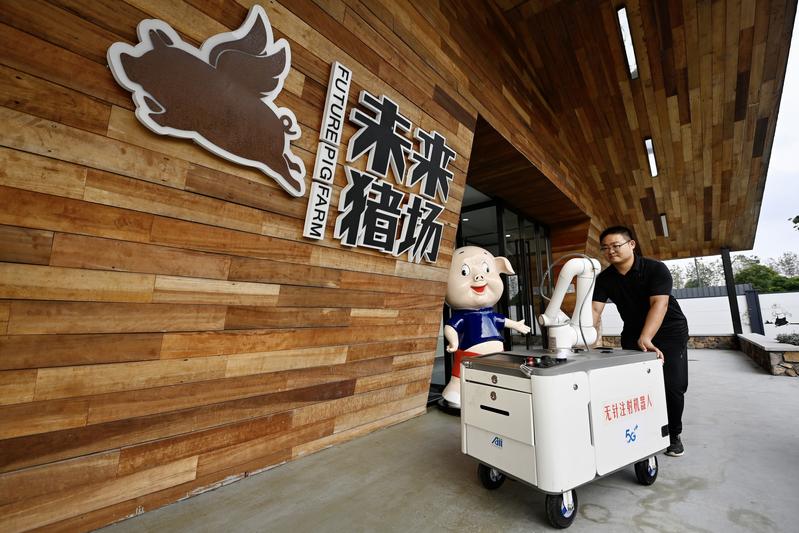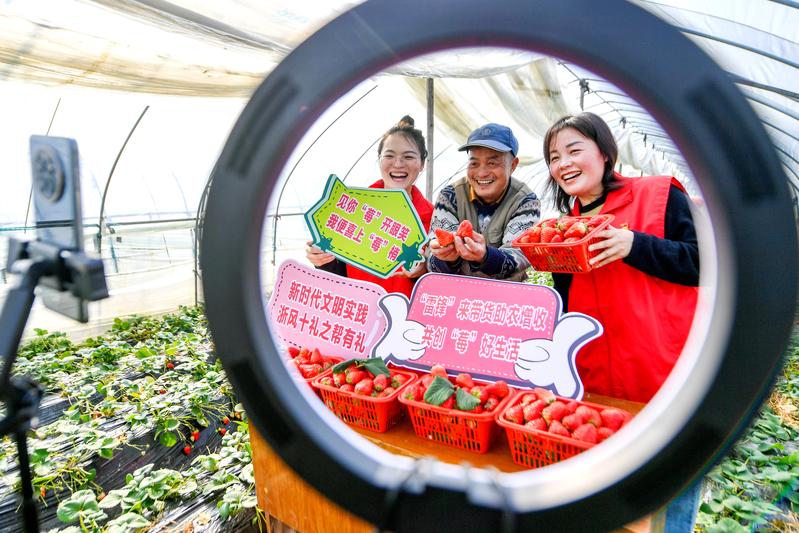Big data, cloud computing, internet create 'planting brain', supporting modernization, lower costs, higher labor efficiency
 An employee moves a needle-free innoculation robot used for a smart pig farm in Wuzhen township, Zhejiang province, in November. (WEI XIAOHAO / CHINA DAILY)
An employee moves a needle-free innoculation robot used for a smart pig farm in Wuzhen township, Zhejiang province, in November. (WEI XIAOHAO / CHINA DAILY)
More cutting-edge technologies have been deployed in agricultural production and smart farm management, promoting advanced agricultural and rural modernization in China.
Among the smart farms in China, one agricultural farm located in Haishu district of Ningbo in East China's Zhejiang province has expanded its footprint by deeply integrating modern technology such as big data, cloud computing and the internet, with traditional agriculture.
"The basic conditions of agriculture in Haishu district are all displayed on the screen in Haishu Future Farm. It presents the variety of seedlings, the real-time situation in the seedling room, the total number of rice plants and the planting conditions in various townships," Lin Jiawei told China Daily.
Lin is an agricultural technician who is responsible for equipment management and data operations at Haishu Future Farm.
Lin explained that the whole system is called a "planting brain", which integrates water and fertilizer, precision planting, nutrient management, pest control, agricultural regulation and monitoring and precision harvesting, largely enhancing agricultural production efficiency.
Haishu Future Farm, originally called the high-quality and high-efficiency rice planting field of digital agricultural technology integration demonstration project, is located in the modern ecological agriculture comprehensive area of Mijiaopian, Gulin township, Haishu district.
"The project aims to accelerate the process of transforming traditional agriculture into modern agriculture, combining agricultural machinery, rice conditions and irrigation with the internet, remote sensing drones and unmanned driving," said Lin.
Located in the western suburbs of Ningbo, Gulin township is a typical water town south of the Yangtze River. In 2017, it was the only digital agriculture planting field project in East China as one of the pilot projects of the Ministry of Agriculture and Rural Affairs.
The project was completed from 2017 to 2022 and was upgraded and renamed Haishu Future Farm in the second half of 2022.
The total construction area of the entire project reaches 7.27 square kilometers and is expected to be completed next month.
"Originally, the project was only aimed at rice cultivation. Now, it expands to almost the whole agricultural industry in Haishu district, including farmlands, orchards and family farms," Lin told China Daily.
"In addition, Haishu Future Farm puts much effort into integrating production, education and research. It also combines agriculture and tourism, attracting many tourists and bringing vitality to the rural economy," said Lin.
"After its completion, it will form a complete high-quality, efficient and precise rice planting technology system and establish a sustainable development operation mechanism. Labor costs of the project area are expected to be reduced by 10 percent, water will be conserved by 10 percent and fertilizer use will be cut by 8 percent," said Lin.
 Strawberry growers promote online sales through livestreaming at a greenhouse in Huzhou, Zhejiang province, on March 3. (TAN YUNFENG / FOR CHINA DAILY)
Strawberry growers promote online sales through livestreaming at a greenhouse in Huzhou, Zhejiang province, on March 3. (TAN YUNFENG / FOR CHINA DAILY)
Besides promoting digital agricultural technology, it enhances the work efficiency of farmers.
Xu Yuejin, a 66-year-old grain farmer, has witnessed the technological advancement of agriculture, as he is now used to using not just primitive hoes, but tractors and drones.
He is responsible for the project's rice planting. His unmanned rice transplanter is equipped with a driverless information system, which can realize automatic rice transplanting and unmanned operations through the internet and Beidou satellite navigation system.
"I have been farming for most of my life and now I can save a lot of labor costs by using unmanned machinery," said Xu.
Xu added that in addition to automatic farming, the base can also realize automatic irrigation, which can save 10 percent of labor costs per year, and save more water while increasing production capacity.
Haishu Future Farm has also built a seedling-raising center, introducing the most advanced seedling-raising equipment across the country. It stresses competitiveness that enables the district to not only meet the needs of its people, but also lead national agricultural development.
In July last year, the Central Cyberspace Administration of China and the Ministry of Agriculture and Rural Affairs jointly held the country's first on-site promotion meeting for digital rural construction in the province, promising to build Zhejiang as the nation's first digital rural area.
Last month, they signed an official cooperation agreement to jointly build a digital rural leading area in Zhejiang, marking the construction of the country's first leading digital village area.
Zhejiang will put more energy into the construction of digital villages in the next few years and strive to build 1,000 digital agricultural factories, 100 future farms and 1,000 rural demonstration villages across the province by 2027.
It is estimated to generate 180 billion yuan ($26.1 billion) in agricultural product retail sales online.
Zhejiang will further accelerate the speed of agricultural and rural digital reform, including industry digital efficiency enhancement, digital service quality improvement, cultural revitalization, governance ability and digital infrastructure improvement in rural areas.
In terms of industrial efficiency, Zhejiang will begin implementing smart agricultural projects, deepen the construction of agricultural industry smart brains and comprehensively integrate industrial, supply, capital and innovation chains.
It will also accelerate the construction of digital agricultural factories and future farms, actively cultivate village livestreaming businesses and seek other new forms of agricultural and rural business.
In addition, Zhejiang will speed up the construction of 5G base stations in rural areas and promote the digital transformation of farmland, water conservancy, road building and cold chain logistics.


